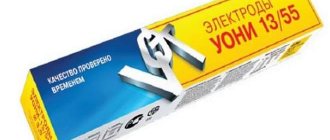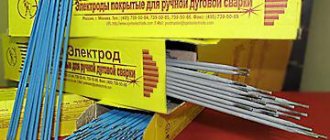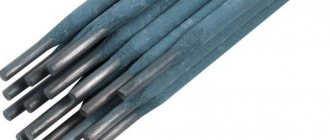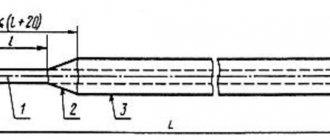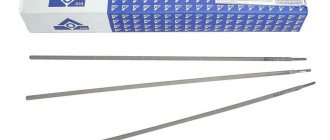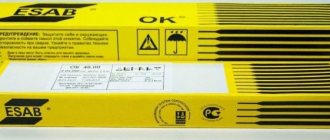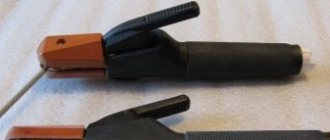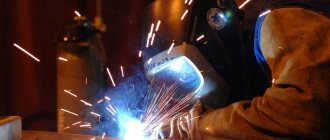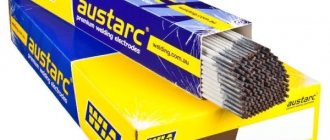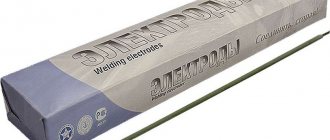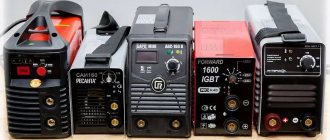One of the most popular materials used for welding low-alloy and carbon steels is UONI-13/55 electrodes. The brand was developed back in 1940, and since then these electrode products have been widely used at industrial facilities in the USSR, and today they are widely used in Russia. The main purpose is welding of critical and especially critical structures that can be operated under high alternating loads (from summer to very low winter temperatures).
How is the marking of UONI 13 electrodes deciphered?
Electrodes for arc welding UONI-13/55 were created by specialists from the laboratory of the then secret Scientific Research Institute No. 13. Hence the decoding characteristic of UONI-13/55:
- U – universal (electrode);
- O – main type of coating;
- N – research;
- I – institute;
- 13 – institute number.
The institution, founded back in 1922 in Petrograd, still operates successfully today. The current name is FSUE “Central Research Institute of Materials”.
Explanation of the designation
The letter “E” indicates that E50A electrodes are designed for use in manual arc welding.
The number “50” is the tensile strength in kgf/mm2. Knowing this value, it is not difficult to calculate the loads that the connection can withstand, which is important for critical structures.
The letter “A” means that the metal of the resulting weld will have increased properties in terms of ductility and impact strength. The designation of electrodes always includes a specific diameter size.
Main features of UONI-13/55 electrodes
In accordance with the requirements of GOST 2246-70, electrodes are made from welding wire grade Sv-08A (carbon steel). The coating is of the basic type. Since it contains calcium fluoride, other fluoride compounds, and carbides, it is also called calcium fluoride.
Electrodes for welding UONI-13/55 also have another name - low hydrogen. They provide extremely low hydrogen content in the weld metal. The possibility of intergranular cracks appearing in such a connection is minimized.
The metal is characterized by high ductility and toughness. The tensile strength indicator is also high - it is 530 MPa. Thanks to these characteristics, welded structures can be used for decades at low temperatures, including in northern latitudes.
Application area
The scope of application here is very wide, since UONI-13 55 electrodes have characteristics that are convenient for almost all industries. They can be found both at home and at construction sites. They are best suited for joining steel structures, since the composition of the deposited metal is as similar as possible to ordinary steel. The connection has a long service life, which is suitable for the construction industry. It is used to repair various products, weld sealed containers, tanks and pipes. The process is high-quality and simple, which only increases the demand. At home, use is complicated by the need for calcination, because it is not always possible to reach such a temperature. In other places this problem does not arise.
Electrodes UONI-13 55 for welding steel structures
Electrodes for welding UONI-13/55 – technical characteristics
Consumable material of this brand provides a fairly high deposition rate - it reaches 9.5 g/Ah. Other indicators include:
- surfacing productivity for a rod with a diameter of 4 mm is 1.4 kg/h;
- per 1 kg of deposited metal, an average of 1.7 kg of electrodes is consumed;
- weld metal yield strength – 420 MPa;
- relative elongation rate – 22%.
The impact strength of the metal is: at t +20 °C – 130 J/cm²; at t -40 °C – 80 J/cm²; at -60 °C – 50 J/cm².
Specifics of SSNI electrodes
In addition to SSNI consumables, their closest analogues, MP-3, are very popular, which have their own advantages, namely:
- can work with direct and alternating current of different polarities;
- suitable for professionals and beginners;
- allow welding at high relative humidity.
Products of the MP-3 brand have rutile coating, and their main disadvantage is the high price.
If we talk about SSSI electrodes, their main technical characteristics are as follows.
- Material - rods made of welding wire Sv-08/08A (13/55).
- Consumption - 1.7 kilograms per 1 kg of molten metal.
- The coating is basic (the composition depends on the model).
- Length – 35-45 centimeters with a diameter of 2-3/4-5 mm.
- The deposition coefficient corresponds on average to the value of 9 g/Ah.
The chemical and mechanical properties of SSNI electrodes are given in the following table.
UONI electrodes equipped with basic coating, unlike rutile analogues, are contraindicated in high-ampere current. The fact is that it causes the release of a large amount of heat, which reduces the quality of the seam being formed. If you ignore this requirement, you can observe:
- warped material;
- increased splashing;
- active evaporation of metal;
- melt leakage;
- making it more difficult to control the weld pool.
Recommended current parameters for products of various diameters are given in the following table
SSNI electrodes are packaged in packs weighing 1 and 5 kilograms. Depending on the diameter of the products, the package can contain from 10 to 100 electrodes.
Features of welding with UONI-13/55 electrodes
The porous base coating has the property of absorbing moisture from the air well, so before welding, the rods must be calcined in an electric furnace at 250 °C for an hour. Other features include:
- the surface of the edges of the parts to be joined must be clean and dry, traces of scale or rust are unacceptable;
- for welding with UONI-13/55 electrodes, only direct current is used, the polarity is reversed;
- Any position of the weld is permissible, except vertical downhill;
The electric arc can be short or medium; thick products, as a rule, are cooked on a short arc.
Calcination of electrodes
Each package must contain a quality certificate and instructions detailing the calcination procedure. If the instructions are not followed, both the quality of the welded products and the quality characteristics of the resulting seam will deteriorate. The calcination procedure must be carried out before using such devices. If they have not been used for 8 hours, then the calcination is repeated again. The same electrode must be processed no more than 3 times , and the total amount of time should not exceed 4 hours.
For high-quality calcination, such devices must first be placed in special boxes and only then in an oven . The operating temperature range of calcination furnaces is from 200 to 300 degrees. Only compliance with the specified conditions will make it possible to make the welding products work for a long time and prevent the formation of various defects during calcination.
We examined UONI 13/55 electrodes. An important feature of their use is calcination . It will allow the welding electrode to work for quite a long time and avoid problems with various defects. When purchasing such devices, it is necessary to have certificates indicating compliance with standards and technical specifications. Take good care of the electrodes and they will last a long time. Good luck with your purchase of welding devices!
Advantages of welding electrodes UONI-13/55
- Fluorides and carbonates of the coating ensure easy ignition of the arc and its stable combustion.
- Thanks to these elements, the weld pool is reliably protected from nitrogen and oxygen. The electrodes are excellent for working in open space and field conditions.
- Metal losses due to spattering or burning out are partially compensated by iron powder, which is also present in the coating. Hence – lower (up to 15%) consumption of rods in comparison with many analogues.
- The metal of the resulting weld, as already mentioned, has excellent impact strength and ductility, and contains a minimum of hydrogen.
Purpose and marking of the product
UONI welding electrodes allow you to create metal structures and steel products that:
- consist of thick-walled parts and elements;
- operated at low temperatures;
- designed for constant increased loads.
In other words, welding is used when forming high-strength joints, as well as when it is necessary to correct defects in parts formed during the casting process. For this reason, the consumables in question are designed for highly qualified craftsmen, while novice welders are recommended to use other, simpler analogues.
If we talk about marking according to GOST, then the decoding of the designation of the electrode UONI E40A-UONI-13/45 SM-3.5UD GOST9467/60 indicates the following parameters.
- E – welding electrode.
- 40 – connection tensile strength in kgf/sq.mm.
- A – viscosity and plasticity of the seam.
- UONI is a product brand that stands for “universal coating of a scientific institute.”
- 13/45 – modification of the welded electrode.
- SM-3.5 – welding wire with a diameter of 3.5 millimeters.
- D – in the design the coating is made in a thick layer.
- U - used for welding carbon steel parts.
Note that, in addition to the letter “U”, the marking of UONI electrodes may include the letters “V”, “L” and “T” (high-alloy, alloy and heat-resistant steel), as well as “H” (indicates the model for surfacing and repair) . In addition, in place of the letter “D” you can find the letters “C” and “M”, which mean that the coating is of medium thickness or thin.
Application of UONI-13/55
The material is widely used in the creation of bridge structures, which is confirmed by its certification by NAKS for such a group of objects as KSM. Also used for installation of oil and gas pipelines, sealing of pipe connections.
Another area of use is construction: connecting assembly elements, reinforcing bars used for the production of reinforced concrete products. Another purpose of electrodes is repair surfacing. They allow you to eliminate cracks when pipes or tanks break.
Features of application
The main technical characteristics of welding electrodes Uoni 1355 consist of the following items:
- for welding with these products you need to use reverse polarity current;
- a special coating of carbonates and fluoride formations, through which the weld practically does not contain gases and other unnecessary impurities;
- Low-carbon steel is used for the rod, which contributes to the long durability of the seam;
- the coating does not contain various organic compounds, due to which such electrodes have a low level of exposure to moisture;
- During the manufacturing process of electrodes, the formation of various irregularities, cracks or swellings is completely eliminated.
We recommend! Difference between UON and MR electrodes
The above factors contribute to the creation of a seam that is not subject to aging and loss of its properties under different temperature conditions.
When welding with electrodes, it is necessary to control the cleanliness of the parts being joined, because the presence of traces of rust or various oils will cause the appearance of pores, and the connection itself will not be reliable. In addition, “stretching” the arc also negatively affects the quality of the weld.
The key competitive advantage of such products over analogues is that the weld is produced with a low hydrogen concentration and is more resistant to the appearance of microcracks during the crystallization process. The most effective result when carrying out actions with Uoni 1355 electrodes can be obtained when welding with a small arc using the supported method.
According to GOST 9466-75, the weight of products in a pack should not exceed:
- 3 kg – for product diameters up to 2.5 mm;
- 5 kg – for a diameter of 3.0 – 4.0 mm;
- 8 kg – for diameters over 4.0 mm.
